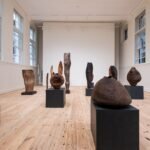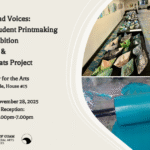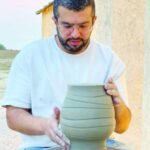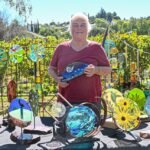
Sculptor and educator Ian Cook is the father of Red Deer Polytechnic’s Visual Arts Program and its celebrated art collection.
Freshly minted University of Alberta Masters of Visual Arts Degree in hand, Ian Cook was hired in 1972 by Red Deer College to teach a pair of university of transfer art electives.
Within a year, the sculptor and holder of two Bachelor of Arts degrees from University of Calgary had created the college’s first Visual Arts Program and began casting what become a half-century artistic and educational legacy that continues.
Cook’s contributions to the field of art and education are being celebrated with “Ian Cook: A Retrospective,” which is running until Nov. 22 at Red Deer Museum and Art Gallery (MAG).
The first two-year Art and Design Diploma Program was only a year old and Cook its first chair when he proposed the creation of the RDC Permanent Art Collection, which was approved in 1974 as a Special Board of Governor’s Project and has come to be recognized as one of Alberta’s most important culture assets. It has more than 1,000 artworks and is the province’s second largest after a collection at University of Lethbridge.
In 1980, he was instrumental in establishing the RDC Bronze Foundry and in 1983 wrote the proposal for a partnership between RDC and the Visual Arts Branch of Alberta Culture, which became the “Summer Series Program,” which has become one of Canada’s most successful adult summer art programs and had nearly 300 participants in 2024.
Cook, who left RDP two years ago, was excited by the prospect of having a lifetime of work on display.
“It’s a great honour just being selected for a retrospective exhibition,” he said this week from his Calgary home. “It’s quite wonderful to see that sort of continuum in the work itself.”
In his artist’s statement accompanying the show, Cook says he has always had a strong interest in architecture, engineering and industrial design. Artistically, that has inspired themes of bridges, airfoils, fences, ancient stone tombs, waterfalls, tornadoes, houses and vessels. His works also reference the four classical elements: earth, water, air and fire.
“I think the way most artists work is they work thematically,” he said in an interview. “They work with ideas that form the conceptual basis for the work.
“There’s this sense of continuity between works and each work becomes a breeder for the next.”
Cook typically explores, shapes and finalizes his sculpture concepts through sketches, many of which are part of the retrospective and provide an insight into the artistic processes behind his visions.
“One of the things the drawings do for me is, in a sense, preview work and I can work out all kinds of ideas for a sculpture. Then I am able through the drawings to choose the ones I feel are the most worthy of being realized as sculpture.”
Throughout his life, Cook has been inspired by nature. A late 1970s drawing field trip with students hosted by the Canmore Alpine Club inspired sculptures, such as Dolmen (a type of ancient stone tomb) and Elevated Stone.
A trip to Greece and Italy led to a fascination with how ancient Greek and Roman temples are ravaged by time, erosion and decay. That led to pieces, such as Kuros and Temple Structure, in 1988. It also inspired Mountain Structure with Contained Rock Fall Slide, which depicts a mountain mine braced by beams to, hopefully, keep nature’s power in check.
Among the most striking works in the retrospective are a series of bronze sculptures inspired by tornadoes and waterspouts he has produced over the past decade.
Both beautiful and terrifying, the works are closely tied to climate change and global warming, which he calls the “greatest environmental crisis affecting modern civilization.
“Tornadoes themselves are a visual paradox,” he writes. “While they can be beautiful and mesmerizing structures to see, they are also an ominous destructive force which has the power to destroy everything within their paths.”
The vulnerability of humans in the face of the power of nature is demonstrated by depictions of houses or sailboats dwarfed by a swirling vortex.
The importance of raising the alarm has only grown more important at a time when U.S. President Donald Trump’s government has virtually made climate change denial official government policy.
Some of the tornado sculptures and a series of fence-inspired sculptures were cast last year and are the most recent pieces in the retrospective.
In the fine tradition of artists such as Claude Monet, who painted well into his 90s, the 82-year-old Cook intends to continue to add to his artistic legacy.
“Age shouldn’t be a limitation in terms of your creativity and continuing your art practise.”











